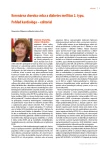Importance of ambulatory blood pressure monitoring and ambulatory ECG monitoring in patients with coronary heart disease
Authors:
Ľudovít Gašpar 1; Iveta Gašparová 2
Authors place of work:
II. interná klinika LF UK a UN Bratislava, prednosta doc. MUDr. Ľudovít Gašpar, CSc.
1; Ústav lekárskej biológie, genetiky a klinickej genetiky LF UK a UN Bratislava, prednosta doc. MUDr. Daniel Böhmer, PhD.
2
Published in the journal:
Forum Diab 2015; 4(1): 45-49
Category:
Hlavná téma
Summary
Cardiovascular diseases are the leading cause of morbidity and mortality in developed countries, including Slovakia. Arterial hypertension, as well as coronary heart disease, are often associated within patient´s polymorbidity. The methods of ambulatory blood pressure monitoring as well as ambulatory ECG monitoring, significantly help in the management of patients with these diseases. Ambulatory blood pressure monitoring is often used in the diagnosis of arterial hypertension, in checking the effectiveness of treatment and determining diurnal index is important as a prognostic point of view. Ambulatory ECG monitoring is especially useful in the detection and quantification of arrhythmias and objectivisation of symptoms which can be correlated with the ECG, both arrhythmias or myocardial ischemia.
Key words:
ambulatory blood pressure monitoring (ABPM) – ambulatory ECG monitoring (Holter ECG) – diurnal index – indications – investigated parameters – patient´s polymorbidity
Zdroje
1. Flegul KM, Graubard BI, Wiliamson DF et al. Cause-specific excess deaths associated with underweight, overweight, and obesity. JAMA 2007; 298(17): 2028–2037.
2. Go AS, Mozzafarian D, Roger VL et al. Heart disease and stroke statistics-2014 update: a report from the American Heart Association. Circulation 2014; 129(3): e28-e292. Dostupné z DOI: <http:// doi: 10.1161/01.cir.0000441139.02102.80>.
3. Narkiewicz K. Obesity and hypertension – the issue is more complex than we thought. Nephrol Dial Transplant 2006; 21(2): 264–267.
4. Patel BM, Metha AA. Aldosterone and angiotensin: Role in diabetes and cardiovascular diseases. Eur J Pharmacol 2012; 697(1–3): 1–12.
5. Bonora E. The metabolic syndrome and cardiovascular disease. Ann Med 2006; 38(1): 64–80.
6. Gašpar Ľ, Balažovjech I. Rezistentná hypertenzia v staršom veku. Vnitř Lék 2013; 59(6): 459–462.
7. Redon J., Cifkova R, Laurent S et al. The metabolic syndrome in hypertension: European society of hypertension position statement. J Hypertens 2008; 26(10): 1891–1900.
8. Biaggioni I. Circadian clocks, autonomic rhythms, and blood pressure dipping. Hypertension 2008; 52(5): 797–798.
9. Gavorník P, Dukát A, Gašpar Ľ. Manažment dyslipidémií – prítomnosť a budúcnosť. Odporúčania Sekcie angiológov Slovenskej lekárskej komory (2013). Vnitř Lék 2013; 59(10): 932–938
10. Skultetyova D, Filipova S, Madaric J et al. Evaluation of carotid artery stiffness and flow-mediated vasodilation in patients with resistant hypertension after renal sympathetic denervation. Cardiology Lett 2014; 23(3): 215–222.
11. Gavorník P. Multivariabilita orgánovovaskulárnych chorôb. In: Gavorník P. Angiológia pre všeobecných lekárov. Dr. Josef Raabe Slovensko: Bratislava 2014: 119–122. ISBN 978–80–8140–083–4.
12. Nasothimiou EG, Karpettas N, Dafni MG et al. Patients preference for ambulatory versus home blood pressure monitoring. J Hum Hypertens 2014; 28(4): 224–229.
13. Boyko EJ, Barr EL, Zimmet PZ et al. Two-hour glucose predicts the development of hypertension over 5 years: the AusDiab study. J Hum Hypertens 2008; 22(3): 168–176.
14. Šimková I et al. Pľúcna hypertenzia očami kardiológa. SAP – Slovak Academic Press: Bratislava 2009. ISBN 978–80–8095–051–4.
15. Hansen TW, Li Y, Boggia J, Thijs L et al. Predictive role of the nightime blood pressure. Hypertension 2011; 57(1): 3–10.
16. Nowbar S, Burkart KM, Gonzales R et al. Obesity – associated hypoventilation in hospitalized patients: prevalence, effects, and outcome. Am J Med 2004; 116(1): 1–7.
17. Verdechia P, Angeli F, Mazzotta G et al. Day-night dip and early-morning surge in blood pressure in hypertension: Prognostic implications. Hypertension 2012; 60(1): 34–42.
18. Kmeč P. Neinvazívna diagnostika porúch srdcového rytmu. Via Pract 2008; 5(6): 246–248.
Štítky
Diabetologie Endokrinologie Interní lékařstvíČlánek vyšel v časopise
Forum Diabetologicum

2015 Číslo 1
- Není statin jako statin aneb praktický přehled rozdílů jednotlivých molekul
- MINISERIÁL: Když ženám stoupá tlak...
- Primární prevence osteoporózy v kostce
- MUDr. Lenka Klimešová: Multioborová vizita může být klíčem k efektivnější perioperační léčbě chronické bolesti
Nejčtenější v tomto čísle
- Klinická diagnostika stabilnej koronárnej choroby srdca
- Význam ambulantného monitorovania krvného tlaku a ambulantného monitorovania EKG u pacientov s koronárnou chorobou srdca
- Koronárna choroba srdca a ženy
- Diabetes mellitus a arytmie
